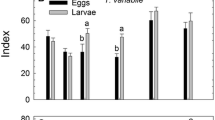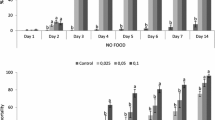Abstract
A series of experiments were conducted to evaluate residual efficacy of the insecticidal pyrrolle chlorfenapyr (Phantom®) on treated concrete for control of Tribolium castaneum (Herbst), assess development of progeny from exposed parental adults, and to determine if starvation before exposure with or without a flour food source increased susceptibility of adult T. castaneum and adult Tribolium confusum Jacqueline du Val to chlorfenapyr. No adults survived exposure on concrete treated with chlorfenapyr at the maximum label rate of 1.1 g active ingredient (AI)/m2, and no progeny were produced in bioassays conducted at 0–8 weeks posttreatment. In the second test, application rates were reduced, and bioassays were conducted at 27 and 32 °C. Adult survival and progeny production decreased as the application rate increased from 28 to 225 mg AI/m2, and survival and progeny production were generally lower at 32 °C than at 27 °C, but at higher rates survival was <1 %, and no progeny were produced. In the final test, adult T. castaneum and adult T. confusum were starved for 1–7 days and then exposed either with or without flour on concrete treated with 3.9 and 27.5 mg AI chlorfenapyr/m2. Mortality generally increased with starvation time, the presence of a food source led to decreased mortality at both application rates, and T. confusum was the more susceptible of the two species. Results show that chlorfenapyr could effectively control both species, but precise dosage levels need to be determined. Also, the presence of a food source greatly compromises adult control.




Similar content being viewed by others
References
Arthur FH (2008a) Efficacy of chlorfenapyr against Tribolium castaneum and Tribolium confusum (Coleoptera: Tenebrionidae) adults exposed on concrete, vinyl tile, and plywood surfaces. J Stored Prod Res 44:145–151
Arthur FH (2008b) Aerosol distribution and efficacy in a commercial food warehouse. Insect Sci 15:133–140
Arthur FH (2009) Efficacy of chlorfenapyr against adult Tribolium castaneum exposed on concrete: effects of exposure interval, concentration and the presence of a food source after exposure. Insect Sci 16:157–163
Arthur FH, Campbell JF (2008) Distribution and efficacy of pyrethrin aerosol to control Tribolium confusum (Coleoptera: Tenebrionidae) in food storage facilities. J Stored Prod Res 44:58–64
Arthur FH, Fontenot EA (2012a) Food source provisioning and susceptibility of immature and adult T. castaneum on concrete partially treated with chlorfenapyr (Phantom®). J Pest Sci 85:277–282
Arthur FH, Fontenot EA (2012b) Methodology for evaluating residual activity of methoprene and novaluron as surface treatments to control Tribolium castaneum and Tribolium confusum. J Insect Sci 12: 95. http://www.insectscience.org/12.95. Accessed 9 May 2013
Arthur FH, Lui S, Zhao B, Phillips TW (2009) Residual efficacy of pyriproxyfen and hydroprene applied to wood, metal and concrete for control of stored-product insects. Pest Manag Sci 65:791–797
Arthur FH, Campbell JF, Toews ME, Fontenot EA (2013) Distribution, abundance, and seasonal patterns of Plodia interpunctella (Hübner) in a commercial food storage facility. J Stored Prod Res 53:7–14
Athanassiou CG, Kavallieratos NG, Chintzoglou GJ (2008a) Effectiveness of spinosad dust against different European populations of the confused flour beetle, Tribolium confusum Jacqueline du Val. J Stored Prod Res 44:47–51
Athanassiou CG, Kavallieratos NG, Yiatilis AE, Vayias BJ, Mavrotas CS, Tomanovic Z (2008b) Influence of temperature and humidity on the efficacy of spinosad against four stored-grain beetle species. J Insect Sci 8:60–69
Campbell JF, Toews MD, Arthur FH, Arbogast RT (2010a) Long-term monitoring of Tribolium castaneum in two flour mills: seasonal patterns and impact of fumigation. J Econ Entomol 103:991–1001
Campbell JF, Toews MD, Arthur FH, Arbogast RT (2010b) Long-term monitoring of Tribolium castaneum populations in two flour mills: rebound after fumigation. J Econ Entomol 103:1002–1011
Huang F, Subramanyam B, Toews MD (2004) Susceptibility of laboratory and field strains of four stored-product insects to spinosad. J Econ Entomol 97:2154–2159
Hunt DA (1996) 2-Arylpyrroles: a new class of insecticide. Structure, activity, and mode of action. Pest Sci 47:201–202
Kavallieratos NG, Athanassiou CG, Vayias BJ, Betsi PCC (2010) Insecticidal efficacy of fipronil against four stored-product insect pests: influence of commodity, dose, exposure interval, relative humidity and temperature. Pest Manag Sci 66:640–649
Kavallieratos NG, Athanassiou CG, Hatzikonstantinou AN, Kavallieratou HN (2011) Abiotic and biotic factors affect efficacy of chlorfenapyr for control of stored-product insect pests. J Food Prot 74:1288–1289
Kljajic P, Peric I (2006) Susceptibility to contact insecticides of granary weevil Sitophilus granarius (L.) (Coleoptera: Curculionidae) originating from different locations in the former Yugoslavia. J Stored Prod Res 42:149–161
Lord JC (2010) Dietary stress increases the susceptibility of Tribolium castaneum to Beauveria bassiana. J Econ Entomol 105:1542–1546
Sutton AE, Arthur FH, Zhu KY, Campbell JF, Murray LW (2011) Residual efficacy of pyrethrin + methoprene aerosol against larvae of Tribolium castaneum and Tribolium confusum (Coleoptera: Tenebrionidae). J Stored Prod Res 47:399–406
Toews ME, Subramanyam B, Rowan JM (2003) Knockdown and mortality of adults of eight species of stored-product beetles exposed to four surfaces treated with spinosad. J Econ Entomol 96:1967–1973
Toews MD, Campbell JF, Arthur FH, West M (2005) Monitoring Tribolium castaneum (Coleoptera: Tenebrionidae) in pilot-scale warehouses treated with residual applications of (S)-hydroprene and cyfluthrin. J Econ Entomol 98:1391–1398
Toews MD, Arthur FH, Campbell JF (2009) Monitoring Tribolium castaneum (Herbst) in pilot-scale warehouses treated with B-cyfluthrin: are residual insecticides and trapping compatible? Bull Entomol Res 99:121–129
Toews MD, Campbell JF, Arthur FH (2010) The presence of flour affects the efficacy of aerosolized insecticides used to treat the red flour beetle, Tribolium castaneum. J Insect Sci 10: 196. http://www.insectscience.org/10.196. Accessed 9 May 2013
Wijayaratne LK, Fields PG, Arthur FH (2012) Residual efficacy of methoprene for control of Tribolium castaneum (Coleoptera: Tenebrionidae) larvae at different temperatures on varnished wood, concrete, and wheat. J Econ Entomol 105:718–725
Acknowledgments
The author thanks B. Barnett and K. Hilger for technical assistance. The author also thanks the BASF Corporation for providing insecticide used in the study and for partial financial support. This paper reports the results of research only. Mention of trade names or commercial products in this publication is solely for the purpose of providing specific information and does not imply recommendation or endorsement by the U.S. Department of Agriculture (USDA). The USDA is an equal opportunity provider and employer.
Author information
Authors and Affiliations
Corresponding author
Additional information
Communicated by C.G. Athanassiou.
Rights and permissions
About this article
Cite this article
Arthur, F.H. Dosage rate, temperature, and food source provisioning affect susceptibility of Tribolium castaneum and Tribolium confusum to chlorfenapyr. J Pest Sci 86, 507–513 (2013). https://doi.org/10.1007/s10340-013-0495-9
Received:
Accepted:
Published:
Issue Date:
DOI: https://doi.org/10.1007/s10340-013-0495-9




